Key takeaways:
- Gender equality advocacy is about breaking down systemic barriers and fostering inclusive environments where all voices are valued.
- Active listening and diverse discussion formats encourage participation and can lead to profound insights and innovative solutions.
- Utilizing technology and guest speakers can broaden participation and enhance the richness of discussions.
- Reflecting on discussions and follow-up engages participants and reinforces the impact of shared experiences, paving the way for ongoing dialogue.
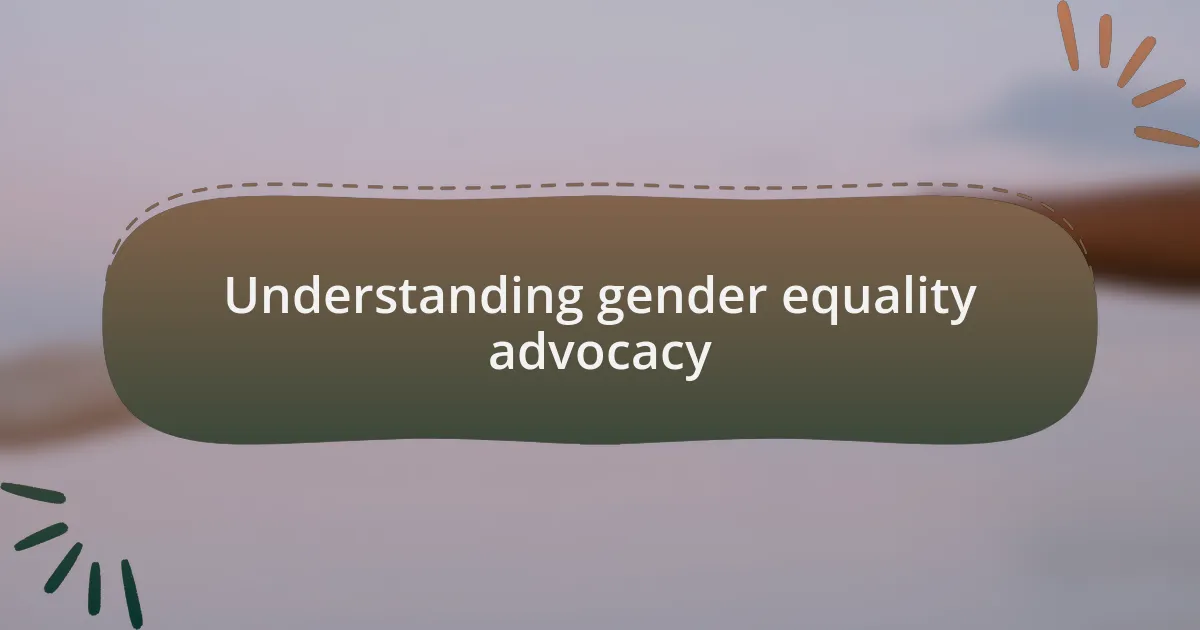
Understanding gender equality advocacy
Gender equality advocacy isn’t just about equal pay; it’s a movement to dismantle systemic barriers that hinder individuals based on their gender. Reflecting on my journey, I’ve seen firsthand how the narratives around gender shape our opportunities. Have you ever wondered how deeply gender stereotypes influence our daily lives?
When I first engaged in gender equality discussions, I was struck by the real stories that people shared. For instance, a friend of mine faced immense pushback when she aimed for a leadership role, simply because she was a woman. It made me reflect: how many brilliant voices are silenced by outdated norms that don’t reflect our potential?
Understanding gender equality advocacy requires an emotional connection to the cause. It’s not just statistics; it’s about recognizing the struggles, dreams, and resilience of individuals. I often ask myself, how can we foster environments where everyone feels valued and empowered? That’s the essence of true advocacy—creating spaces for inclusive dialogues where all experiences are honored.
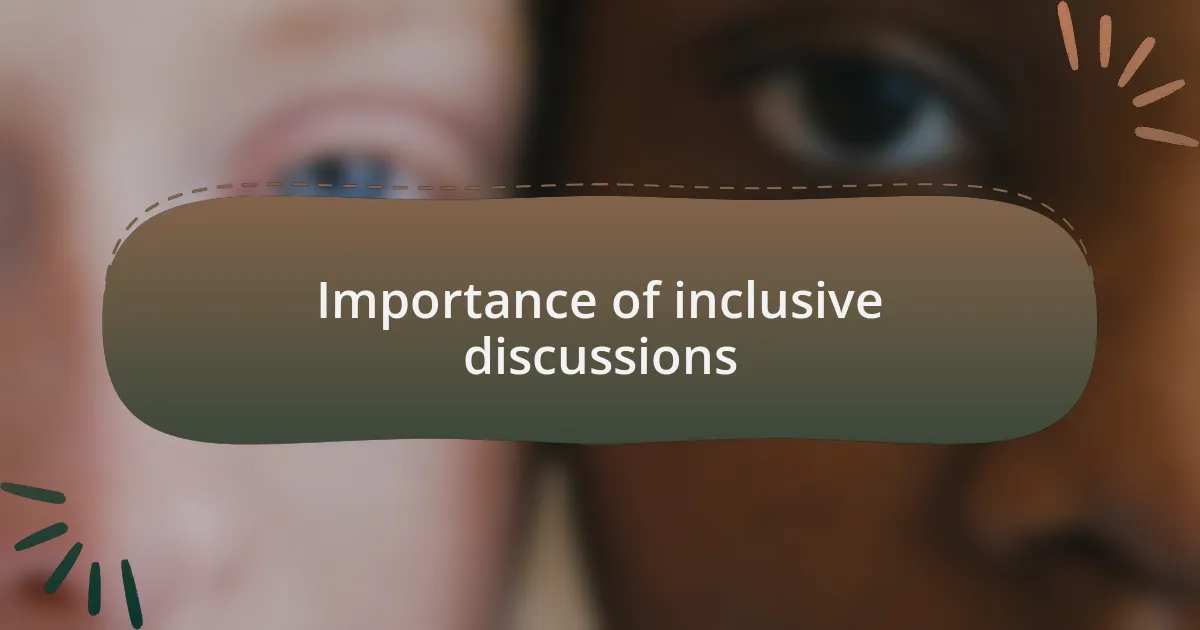
Importance of inclusive discussions
Inclusive discussions serve as a vital foundation for promoting gender equality. From my experience, when everyone is invited to voice their opinions, we uncover diverse perspectives that enrich the conversation. Have you noticed how a single story can shift our understanding in profound ways?
I remember participating in a workshop where individuals from various backgrounds shared their experiences with gender biases. Listening to their struggles and triumphs opened my eyes to the different challenges people face. It became clear to me that fostering an environment where everyone feels comfortable sharing can lead to innovative ideas and solutions.
Creating inclusive dialogues is not just beneficial; it’s essential for progress. Each contribution, whether big or small, adds to the collective knowledge and strengthens our advocacy efforts. When we embrace all voices, we challenge the status quo. Isn’t it exciting to think about the possibilities when we unite in our differences?
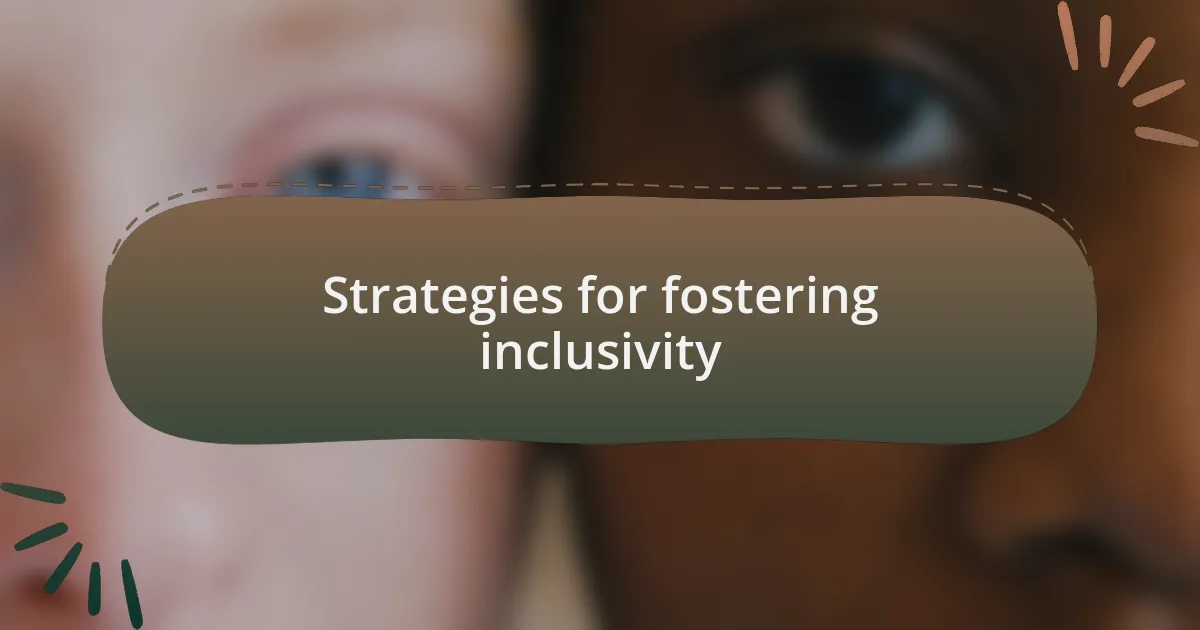
Strategies for fostering inclusivity
One effective strategy for fostering inclusivity is to implement active listening practices. I recall a community meeting where we set aside time solely for listening to people without interruptions. This simple yet powerful approach allowed everyone to voice their thoughts, and I was amazed at the depth of insights shared. Have you ever noticed how allowing silence for reflection encourages more thoughtful contributions? It not only validates participants but also creates a safer space for sharing sensitive ideas.
Another approach I’ve found valuable is to incorporate diverse formats for discussion. For instance, I once facilitated a session that blended traditional open forums with breakout groups. This hybrid style appealed to those who might be shy in large groups and encouraged quieter voices to shine through. It’s intriguing how different settings can inspire participants to share more authentically. Have you experienced a format that transformed your conversation dynamics?
Finally, establishing a norm of respect and openness around differing opinions is crucial. In my experience, openly acknowledging disagreements can be liberating. Once, during a heated discussion on policy changes, I encouraged everyone to express dissenting views, which led to unexpected breakthroughs. The tension transformed into a vibrant dialogue that uncovered new angles we had not considered. Why do you think creating space for disagreement is often overlooked? Embracing these moments can not only enhance understanding but ultimately drive our movement for gender equality forward.
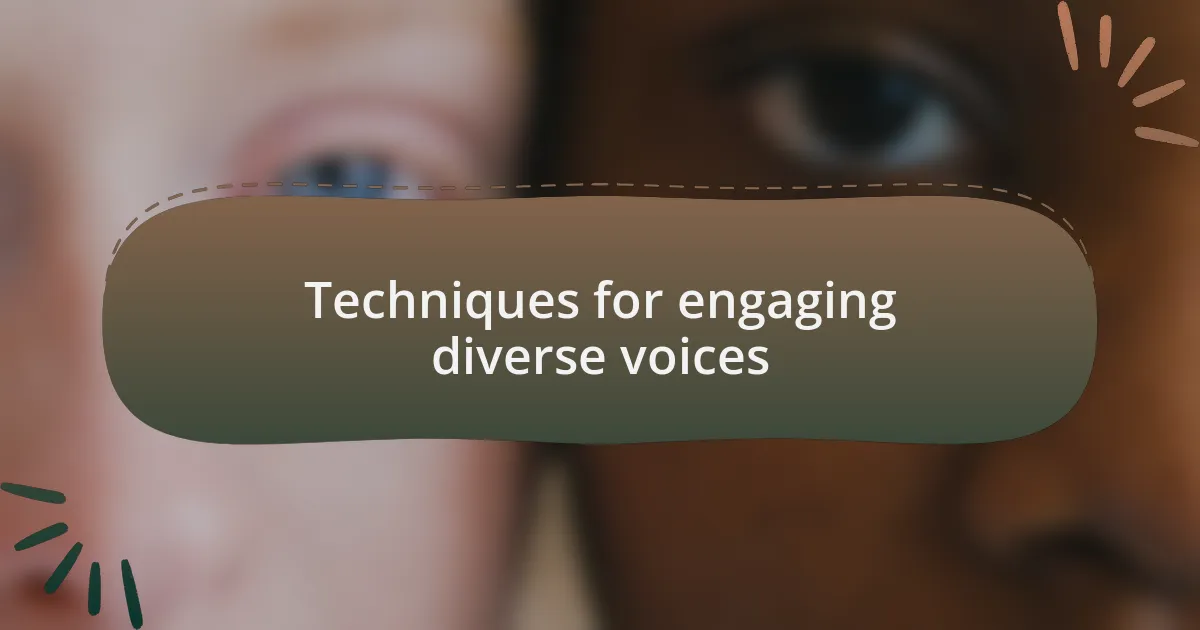
Techniques for engaging diverse voices
A technique I have found particularly effective is to invite guest speakers from varied backgrounds to share their perspectives. I remember hosting a panel discussion that featured voices from different communities, including folks from backgrounds and various cultural identities. The stories they shared were so rich and moving that they sparked deeper conversations among the attendees. Have you ever listened to someone who completely reshaped your understanding of an issue just by sharing their lived experience?
Creating structured opportunities for feedback can also be a game-changer. In one of my workshops, I used anonymous surveys to gather input on sensitive topics before discussing them openly. I was pleasantly surprised to uncover thoughts that might not have emerged in a typical setting. This approach not only elevated voices that often go unheard but also fostered a sense of trust. Have you tried a similar method that led to unexpected insights?
Lastly, utilizing technology to connect people can broaden participation tremendously. During the pandemic, I hosted virtual discussions that included participants from different time zones, making it possible for everyone to join in. The digital platform allowed for a more dynamic exchange, and I witnessed firsthand how geographical barriers could vanish, giving rise to diverse viewpoints. Isn’t it fascinating how technology can serve as a bridge in fostering inclusive conversations?
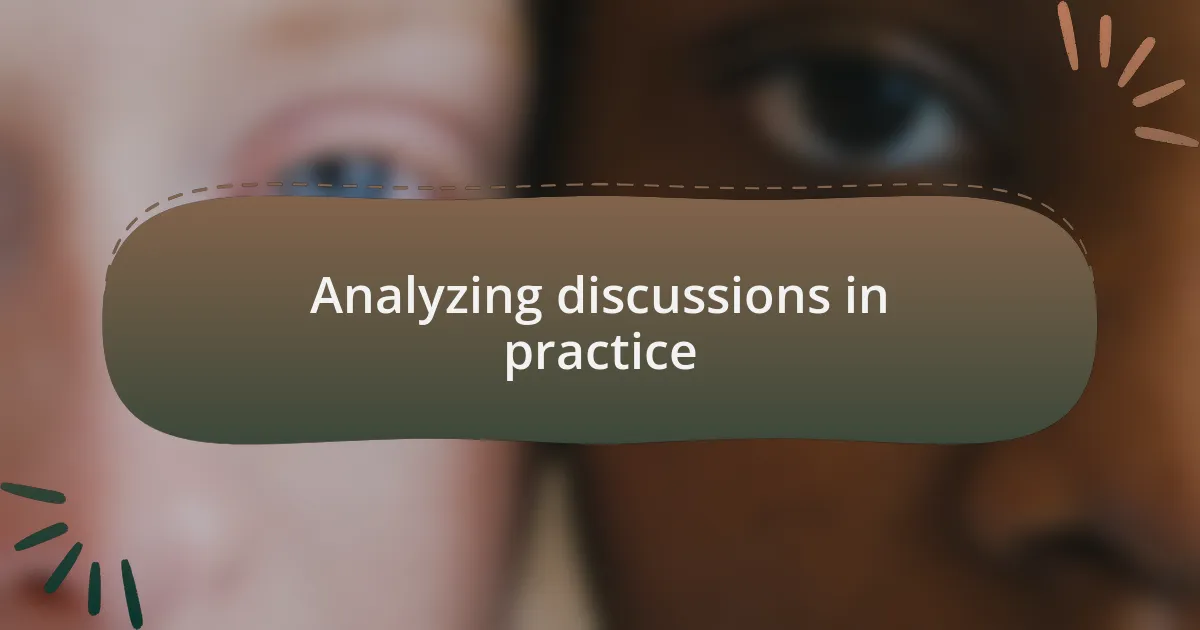
Analyzing discussions in practice
Analyzing discussions in practice requires a keen ear and a reflective mindset. After each session, I found it invaluable to revisit the transcripts or recordings, paying close attention to the nuances of how participants interacted. I once noted that moments of silence often revealed more than words; it was in those pauses that discomfort or deep contemplation lingered. Have you ever noticed how silence can be a powerful tool in understanding emotional layers?
I also learned that not all contributions hold the same weight in discussions, and that’s okay. For instance, during one conversation, a participant from a marginalized community shared an experience that challenged some common assumptions. The way the room shifted—eyes widened, and nods of understanding spread—was palpable. It underscored how vital it is to recognize and affirm these pivotal moments. How do you respond in such instances to ensure that everyone feels seen and valued?
Creating a culture of analyzing discussions doesn’t stop at reflection; it involves actionable steps. I implemented follow-up discussions where participants could express how their perspectives had evolved after our talks. This approach not only reinforced what had been learned but also nurtured ongoing connections. Have you ever experienced the growth that comes from revisiting a topic with fresh eyes? It can truly illuminate paths for deeper understanding.

My personal experiences with inclusivity
Inclusivity has always been a personal commitment for me, shaped by real-life encounters. I recall a workshop where I intentionally invited participants from diverse backgrounds, including those often overlooked. Watching their hesitancy transform into engagement was nothing short of inspiring. It made me realize how inclusive spaces help to unlock voices that usually remain silent. Have you ever witnessed a shy speaker blossom in an inclusive setting?
There was one memorable instance when a young woman shared her struggle with gender bias in her workplace. The raw emotion in her voice struck a chord with everyone present, and it prompted an open dialogue that felt almost electric. I felt a sense of duty to ensure her experience was acknowledged and validated. That moment taught me the importance of listening—not just hearing the words, but truly understanding the lived realities behind them. Have you ever felt the weight of someone’s story change the atmosphere in the room?
Part of my journey involves creating safe spaces where everyone can articulate their thoughts without fear of judgment. I’ve implemented small group discussions, allowing quieter voices to emerge more comfortably. It’s impressive how much deeper conversations can become when everyone feels secure enough to share. This approach has enriched my understanding of inclusivity. Have you ever found that the loudest voices can sometimes drown out the most insightful ones?
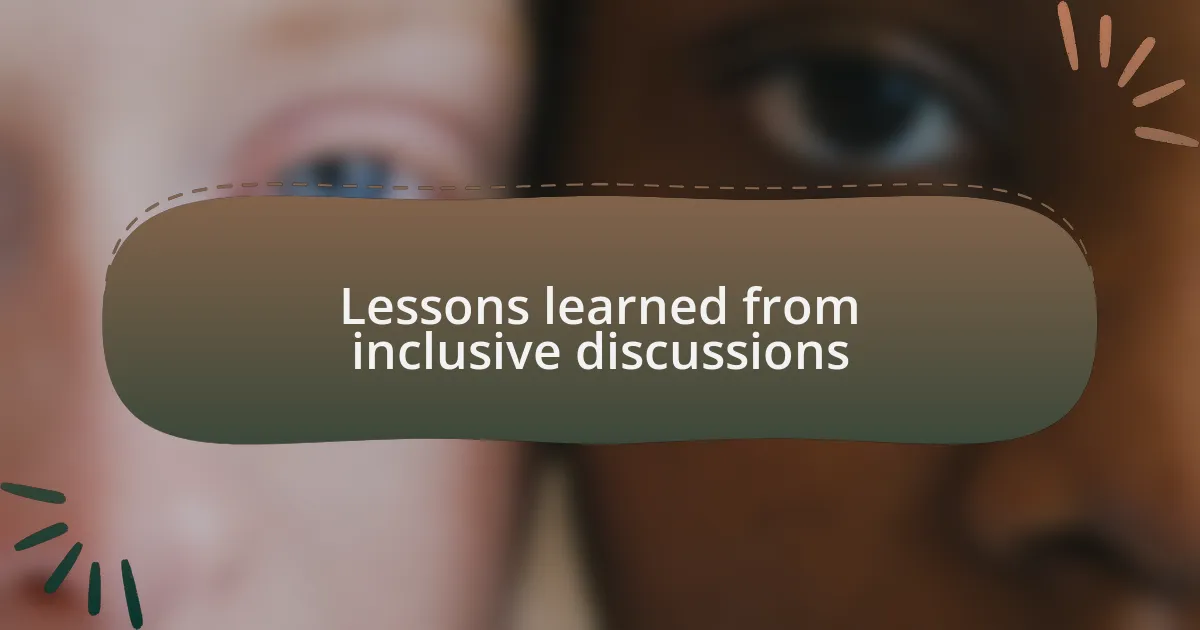
Lessons learned from inclusive discussions
Engaging in inclusive discussions has taught me that everyone brings unique perspectives to the table. During a recent forum, I encouraged participants to share their experiences related to gender equality, expecting a mix of stories and insights. What surprised me was how one individual’s narrative about overcoming societal barriers resonated with others, creating a ripple effect of shared vulnerabilities. Have you ever noticed how one person’s story can unlock a wave of understanding in a group?
Moreover, I’ve learned that fostering inclusivity requires patience and active engagement. In one discussion, I facilitated an activity where participants had to address myths and realities surrounding gender roles. The initial apprehension quickly transformed into spirited conversations. It reminded me that when people feel genuinely included, they can confront even the toughest topics. Have you experienced moments in dialogue where discomfort leads to growth?
Finally, I now appreciate the value of follow-up after inclusive discussions. After a particularly impactful session on intersectionality, I reached out to participants for feedback on their thoughts and feelings post-discussion. Many expressed a newfound sense of empowerment and the desire to continue these conversations beyond the forum. Have you ever followed up with participants and discovered gems of insight that could further enrich future discussions?